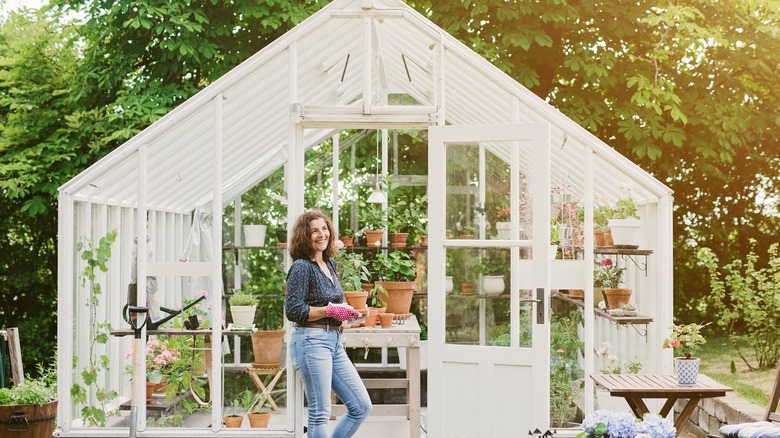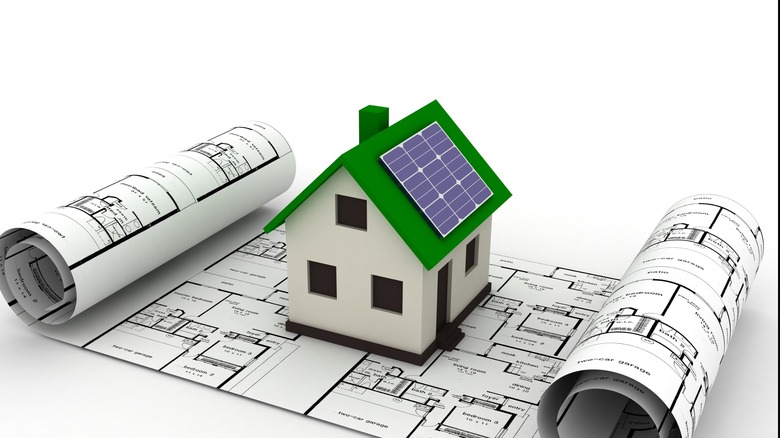What To Know Before Adding Solar Panels To Your Greenhouse
Personal greenhouses are an excellent way to extend the growing season for any region throughout the United States and Canada. By starting seeds well before the last frost date, it's possible to cultivate tender seedlings inside a greenhouse's warm, protected environment. However, you may need to harden your seedlings before transferring them into your prepared garden beds. The best way to harden seedlings is by setting them outside in a shady spot protected from the wind during warm days for a week or two, increasing direct sunlight a little each day, and bringing them back into the greenhouse during cold nights.
In addition to a protected environment, backyard greenhouses allow gardeners to control the water their plants receive. In many cases, overwatering is just as detrimental as the lack of water, especially for young plants. While some gardeners enjoy the hands-on approach to tending greenhouse plants, an advantage of modern greenhouses is you can add automated routines that regulate the amount and timing of water to seedlings, control ventilation fan timing, and open and close vents.
Systems that control those things require electricity. While some may live in an area not subject to code enforcement, most home improvement projects, including supplying electricity to your backyard greenhouse, require permits and a qualified electrician. However, adding a simple 12-volt solar power system to your greenhouse is an easy DIY project that only requires basic tools.
Manage your expectations
First, you should know that while solar power is an effective solution for many electrical power needs, simple systems deliver small amounts of power. While your home's electrical outlets deliver what seems like unlimited electrical power to anything you can plug into them, electricians calculate expected electrical current needs and size your home's electrical systems using variations of the formula: Volts multiplied by Amps equals Watts.
A 15 amp, 120-volt circuit in your home provides 1,800 watts of power. Conversely, powering an appliance using 1,800 watts divided by 120 volts draws 15 amps from the power grid. Solar-powered electricity is bound by the same rule. A typical 100-watt solar panel produces around five amps at 20 volts during the few hours per day they see direct sunlight.
Electrical energy production is limited in stand-alone solar power systems and fluctuates from peak power when exposed to full sunlight to zero production after sunset. That's why most solar power systems utilize a battery bank to store excess energy produced during peak times for use after dark. A simple 12-volt system costing under $500 can power water timers, a small fan at times, vent system actuators, and minimal use of an LED light. Systems that pump water, provide heat, or keep multiple lights on throughout the night are complex and cost more.
Professional advice is recommended for DIY systems
It's important to realistically evaluate your DIY skill level, especially when it comes to designing your greenhouse solar power system. The good news is that many reputable solar equipment suppliers offer pre-designed kits complete with proper-sized electrical cables, fuses, switches, detailed schematics, and necessary equipment. If you cannot find a kit to meet your needs, most suppliers will help design a system specifically for you for free or at minimal cost. Call around to get the best deal and service.
Another critical piece of information to know before starting your DIY solar installation is how the system functions. First, of course, solar panels use sunlight to generate electricity that's sent to a solar charge controller via electric cables. Solar panel electrical output varies depending on the amount of sunlight they receive. The solar charge controller manages those variances, providing optimum electrical output to the system. When the electrical demand is greater than the charge controller output, the system draws from the battery, and when demand is lower, the excess power goes to charge the system's battery bank.


